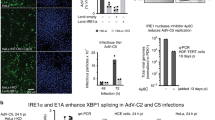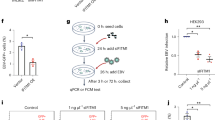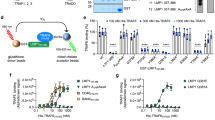Abstract
Although frequently expressed in Epstein–Barr virus (EBV)-positive malignancies, the role that latent membrane protein 2A and 2B (LMP2A and LMP2B) have in the oncogenic process remains obscure. Here we show a novel function for these proteins in epithelial cells, namely, their ability to modulate signalling from type I/II interferon receptors (IFNRs). We show that LMP2A- and LMP2B-expressing epithelial cells show decreased responsiveness to interferon (IFN)α and IFNγ, as assessed by STAT1 phosphorylation, ISGF3 and GAF-mediated binding to IFN-stimulated response element and IFNγ-activated factor sequence elements and luciferase reporter activation. Transcriptional profiling highlighted the extent of this modulation, with both viral proteins impacting ‘globally’ on IFN-stimulated gene expression. Although not affecting the levels of cell-surface IFNRs, LMP2A and LMP2B accelerated the turnover of IFNRs through processes requiring endosome acidification. This function may form part of EBV's strategy to limit anti-viral responses and define a novel function for LMP2A and LMP2B in modulating signalling from receptors that participate in innate immune responses.
This is a preview of subscription content, access via your institution
Access options
Subscribe to this journal
Receive 50 print issues and online access
$259.00 per year
only $5.18 per issue
Buy this article
- Purchase on Springer Link
- Instant access to full article PDF
Prices may be subject to local taxes which are calculated during checkout






Similar content being viewed by others
References
Adachi K, Ichinose T, Takizawa N, Watanabe K, Kitazato K, Kobayashi N . (2007). Inhibition of betanodavirus infection by inhibitors of endosomal acidification. Arch Virol 152: 2217–2224.
Allen MD, Young LS, Dawson CW . (2005). The Epstein–Barr virus-encoded LMP2A and LMP2B proteins promote epithelial cell spreading and motility. J Virol 79: 1789–1802.
Anderson LJ, Longnecker R . (2008a). An auto-regulatory loop for EBV LMP2A involves activation of Notch. Virology 371: 257–266.
Anderson LJ, Longnecker R . (2008b). Epstein Barr virus latent membrane protein 2A exploits Notch1 to alter B cell identity in vivo. Blood 113: 108–116.
Beadling C, Ng J, Babbage JW, Cantrell DA . (1996). Interleukin-2 activation of STAT5 requires the convergent action of tyrosine kinases and a serine/threonine kinase pathway distinct from the Raf1/ERK2 MAP kinase pathway. EMBO J 15: 1902–1913.
Cassady KA, Gross M . (2002). The herpes simplex virus type 1 U(S)11 protein interacts with protein kinase R in infected cells and requires a 30-amino-acid sequence adjacent to a kinase substrate domain. J Virol 76: 2029–2035.
Cho NH, Kingston D, Chang H, Kwon EK, Kim JM, Lee JH et al. (2006). Association of herpesvirus saimiri tip with lipid raft is essential for downregulation of T-cell receptor and CD4 coreceptor. J Virol 80: 108–118.
Claudinon J, Monier MN, Lamaze C . (2007). Interfering with interferon receptor sorting and trafficking: impact on signalling. Biochimie 89: 735–743.
Conrad M, Bubb VJ, Schlegel R . (1993). The human papillomavirus type 6 and 16 E5 proteins are membrane-associated proteins which associate with the 16-kilodalton pore-forming protein. J Virol 67: 6170–6178.
Dawson CW, Eliopoulos AG, Blake SM, Barker R, Young LS . (2000). Identification of functional differences between prototype Epstein–Barr virus-encoded LMP1 and a nasopharyngeal carcinoma-derived LMP1 in human epithelial cells. Virology 272: 204–217.
Dawson CW, George JH, Blake SM, Longnecker R, Young LS . (2001). The Epstein-Barr virus encoded latent membrane protein 2A augments signaling from latent membrane protein 1. Virology 289: 192–207.
Dykstra ML, Longnecker R, Pierce SK . (2001). Epstein–Barr virus coopts lipid rafts to block the signalling and antigen transport functions of the BCR. Immunity 14: 57–67.
Ikeda M, Longnecker R . (2007). Cholesterol is critical for Epstein–Barr virus latent membrane protein 2A trafficking and protein stability. Virology 360: 461–468.
Katze MG . (2002). Interferon, PKR, virology, and genomics: what is past and what is next in the new millennium? J Interferon Cytokine Res 22: 283–286.
Li Q, Means R, Lang S, Jung JU . (2007). Downregulation of gamma interferon receptor 1 by Kaposi's sarcoma-associated herpesvirus K3 and K5. J Virol 81: 2117–2127.
Liu J, Plotnikov A, Banerjee A, Suresh Kumar KG, Ragimbeau J, Marijanovic Z et al. (2008). Ligand-independent pathway that controls stability of interferon alpha receptor. Biochem Biophys Res Commun 367: 388–393.
Longan L, Longnecker R . (2000). Epstein–Barr virus latent membrane protein 2A has no growth-altering effects when expressed in differentiating epithelia. J Gen Virol 81: 2245–2252.
Longnecker R . (2000). Epstein–Barr virus latency: LMP2, a regulator or means for Epstein–Barr virus persistence? Adv Cancer Res 79: 175–200.
Mancao C, Hammerschmidt W . (2007). Epstein–Barr virus latent membrane protein 2A is a B-cell receptor mimic and essential for B-cell survival. Blood 110: 3715–3721.
Morrison JA, Klingelhutz AJ, Raab-Traub N . (2003). Epstein–Barr virus latent membrane protein 2A activates β-catenin signalling in epithelial cells. J Virol 77: 12276–12284.
Morrison TE, Mauser A, Wong A, Ting JP, Kenney SC . (2001). Inhibition of IFN-gamma signalling by an Epstein–Barr virus immediate-early protein. Immunity 15: 787–799.
Nanbo A, Takada K . (2002). The role of Epstein–Barr virus-encoded small RNAs (EBERs) in oncogenesis. Rev Med Virol 12: 321–326.
Offermann MK . (2007). Kaposi sarcoma herpesvirus-encoded interferon regulator factors. Curr Top Microbiol Immunol 312: 185–209.
Ogino T, Moriai S, Ishida Y, Ishii H, Katayama A, Miyokawa N et al. (2007). Association of immunoescape mechanisms with Epstein–Barr virus infection in nasopharyngeal carcinoma. Int J Cancer 120: 2401–2410.
Raab-Traub N . (2002). Epstein–Barr virus in the pathogenesis of NPC. Semin Cancer Biol 12: 431–441.
Ragimbeau J, Dondi E, Alcover A, Eid P, Uze G, Pellegrini S . (2003). The tyrosine kinase Tyk2 controls IFNAR1 cell surface expression. EMBO J 22: 537–547.
Randall RE, Goodbourn S . (2008). Interferons and viruses: an interplay between induction, signalling, antiviral responses and virus countermeasures. J Gen Virol 89: 1–47.
Rechsteiner MP, Berger C, Weber M, Sigrist JA, Nadal D, Bernasconi M . (2007). Silencing of latent membrane protein 2B reduces susceptibility to activation of lytic Epstein–Barr virus in Burkitt's lymphoma Akata cells. J Gen Virol 88: 1454–1459.
Rechsteiner MP, Berger C, Zauner L, Sigrist JA, Weber M, Longnecker R et al. (2008). Latent membrane protein 2B regulates susceptibility to induction of lytic Epstein–Barr virus infection. J Virol 82: 1739–1747.
Rezaee SA, Cunningham C, Davison AJ, Blackbourn DJ . (2006). Kaposi's sarcoma-associated herpesvirus immune modulation: an overview. J Gen Virol 87: 1781–1804.
Rovedo M, Longnecker R . (2007). Epstein–Barr virus latent membrane protein 2B (LMP2B) modulates LMP2A activity. J Virol 81: 84–94.
Scholle F, Bendt KM, Raab-Traub N . (2000). Epstein–Barr virus LMP2A transforms epithelial cells, inhibits cell differentiation, and activates Akt. J Virol 74: 10681–10689.
Stewart S, Dawson CW, Takada K, Curnow J, Moody CA, Sixbey JW et al. (2004). Epstein–Barr virus-encoded LMP2A regulates viral and cellular gene expression by modulation of the NF-kappaB transcription factor pathway. Proc Natl Acad Sci USA 101: 15730–15735.
Tao Q, Chan AT . (2007). Nasopharyngeal carcinoma: molecular pathogenesis and therapeutic developments. Expert Rev Mol Med 9: 1–24.
Uozaki H, Fukayama M . (2008). Epstein–Barr virus and gastric carcinoma—viral carcinogenesis through epigenetic mechanisms. Int J Clin Exp Pathol 1: 198–216.
Young LS, Rickinson AB . (2004). Epstein–Barr virus: 40 years on. Nat Rev Cancer 4: 757–768.
Acknowledgements
This work was supported by programme funding from Cancer Research UK and the European Commission's FP6 Life Sciences Health Programme (INCA project LSHC-CT-.2005-018704).
Author information
Authors and Affiliations
Corresponding author
Additional information
Supplementary Information accompanies the paper on the Oncogene website (http://www.nature.com/onc)
Rights and permissions
About this article
Cite this article
Shah, K., Stewart, S., Wei, W. et al. The EBV-encoded latent membrane proteins, LMP2A and LMP2B, limit the actions of interferon by targeting interferon receptors for degradation. Oncogene 28, 3903–3914 (2009). https://doi.org/10.1038/onc.2009.249
Received:
Revised:
Accepted:
Published:
Issue Date:
DOI: https://doi.org/10.1038/onc.2009.249
Keywords
This article is cited by
-
The molecular march of primary and recurrent nasopharyngeal carcinoma
Oncogene (2021)
-
PARP11 regulates total levels of type-I interferon receptor IFNAR1
Nature Microbiology (2019)
-
The regulatory role of protein phosphorylation in human gammaherpesvirus associated cancers
Virologica Sinica (2017)
-
Epstein–Barr virus latent genes
Experimental & Molecular Medicine (2015)
-
The role of Epstein-Barr virus infection in the pathogenesis of nasopharyngeal carcinoma
Virologica Sinica (2015)



